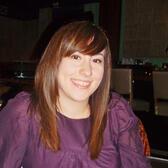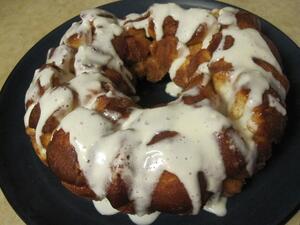Eating Jewish: Aranygaluska, or "Hungarian monkey bread"
Earlier this month, The Jew and the Carrot published an article by Leah Koenig entitled “Jewish Dishes We Miss: A Top-10 List of Ashkenazi Foods To Bring Back.” Prior to publishing this list, readers were asked to write in with their own suggestions as to which dishes should go on this list and in the end it was made up of the following ten dishes: schmaltz (rendered poultry fat), gribenes (poultry skin cracklings), schav (sorrel and sorrel soup), tongue, mamaliga (cornmeal porridge), russel (fermented beets), eyerlekh (unhatched eggs), belly lox, p’tcha (jellied calf’s foot), and aranygaluska (pull apart cake). I could write blog posts about each of these dishes (admittedly some are more appealing than others) but the one that caught my attention was aranygaluska. The name wasn’t familiar but as soon as I started reading its description I immediately realized that I knew this dessert of cinnamon and sugar covered yeast dough balls, under the guise of monkey bread. This revelation immediately sent me to my stacks of cookbooks and to the Internet to find out why I knew this Hungarian Jewish dessert under another name.
I first read about this dessert just over a year ago on the Smitten Kitchen blog but there was no mention of any connection to Jewish cuisine. Rather, the Smitten Kitchen posts explains that this dessert could be found in cookbooks and women’s magazines in the United States starting in the 1950s and Nancy Regan popularized this dish when she served it in the White House for Christmas. The dough balls of the monkey bread known during this period were simply dipped in melted butter and then baked in a tube pan or a Bundt pan.
Yet, upon turning to the Encyclopedia of Jewish Food by Gil Marks, the entry for aranygaluska provides the history of this Hungarian Jewish dessert and includes an explanation as to why many people now know it as monkey bread. The name aranygaluska literally means “golden dumpling” and by the 1880s, this dessert was being referred to in Hungarian literature. Hungarian immigrants subsequently brought this dish with them when they immigrated to America and began introducing it into the country’s food landscape when Hungarian and Hungarian Jewish bakeries began selling it in the mid-twentieth century. In 1972, a cookbook published by Betty Crocker included a recipe for aranygaluska, which they referred to as “Hungarian Coffee Cake.” As it became more popular in America, aranygaluska came to be confused with monkey bread in which the balls of dough are not dipped in cinnamon and sugar but only in butter. Monkey bread soon became the more common name for this Hungarian Jewish dessert and therefore what most people know as monkey bread today is actually aranygaluska.
Despite its confusing history, I can promise you that this dish isn’t as complicated as to make and produces a dessert that is a wonderful cross between cinnamon buns and doughnut holes. This recipe will take a few hours to make from start to finish, of which the majority of this time will be spent waiting for the dough to rise. I made this dough by hand and found that this recipe produces a dough that is heavy and firm and it's quite the workout to get the smooth, satiny texture that the recipe calls for. Don’t worry though, after about ten minutes of kneading the dough will suddenly become smooth and you can give your arms a rest. In the next step, when dipping the balls into butter and the cinnamon sugar mixture, it’s nice to have a clean pair of hands that aren’t covered in cinnamon and sugar to help you along. Finally, when placing the dough in the Bundt pan make sure to place the pieces close together so that they stick together into one round loaf when they bake and don’t fall apart when the bread is unmolded.
This is the perfect dessert to serve to a group of people, allowing everyone to rip off their own pieces of dough (and because you don’t want to be alone in the house with this dessert because you won’t be able to stop eating it, not that this happened to me of course!). So go ahead and make this as soon as possible, because not only is it a great way to use up flour before Passover, but I also have no doubt it will become one of your favorite desserts.
After reading the list I discussed at the beginning of the post are there any Jewish dishes that you would like to see brought back and in turn like me to blog about? I’d love to hear your suggestions, whether they are Ashkenazi or Sephardic.
Aranygaluska (a.k.a Monkey bread)
From Smitten Kitchen
Dough
4 tablespoons unsalted butter, divided (2 tablespoons softened, 2 tablespoons melted)
1 cup milk, warm (around 110 degrees)
1/3 cup water, warm (also around 110 degrees)
¼ cup granulated sugar
1 package or 2 ¼ teaspoons rapid rise, instant or bread machine yeast
3 ¼ cups all-purpose flour, plus extra for work surface
2 teaspoons table salt
Brown Sugar Coating
1 cup packed light brown sugar
2 teaspoons ground cinnamon
8 tablespoons unsalted butter, melted
Cream Cheese Glaze (You can serve it with or without this glaze, it’s delicious either way)
3 ounces cream cheese, softened
3 tablespoons powdered sugar, plus extra if needed
2 tablespoons milk, plus extra if needed
¼ teaspoon vanilla extract
-
Adjust oven rack to medium-low position and heat oven to 200 degrees and turn it off when it reaches this temperature.
-
In a large measuring cup, mix together milk, water, melted butter, sugar, and yeast.
-
If you have a stand mixer, mix flour and salt in the mixer that has been fitted with a dough hook. Turn machine on to low and slowly add the milk mixture. Once the dough comes together, increase the speed to medium and mix until the dough is shiny and smooth, 6 to 7 minutes. (The dough should be sticky but if it is too wet to come together into a ball, add an additional 2 tablespoons flour.) Turn dough onto lightly floured surface and knead briefly to form smooth, round ball.
-
If you’re making the dough by hand, mix the flour and salt in large bowl. Make well in the flour, then pour the milk mixture into the well. Using a wooden spoon, mix until the dough becomes shaggy and is difficult to stir with the spoon. Turn the dough out onto lightly floured surface and begin to knead, incorporating shaggy scraps back into dough. Knead until the dough is smooth and satiny, about 10 minutes.
-
Coat a large bowl with nonstick cooking spray or a tablespoon of neutral oil (like vegetable oil). Place the dough in the bowl and coat surface of the dough in cooking spray or oil by rolling in around in the bowl. Cover the bowl with plastic wrap or a damp kitchen towel and place in the warm oven until the dough doubles in size, about 50 to 60 minutes.
-
For the brown sugar coating place melted butter in one bowl. Mix brown sugar and cinnamon in a second one. Set aside.
-
Butter the Bundt pan with softened butter.
-
Place the dough onto a lightly floured surface and gently pat into an 8-inch square. Cut dough into 64 pieces. Roll each piece of dough into a ball and working one at a time, dip the balls in melted butter, allowing excess butter to drip back into bowl. Roll in the brown sugar mixture, and then layer the balls in Bundt pan, staggering the seams where dough balls meet as you build layers. Also, make sure to that the dough balls are placed close together.
-
Cover the Bundt pan tightly with plastic wrap and place in the turned-off oven until dough balls have risen 1 to 2 inches from top of pan, about 50 to 70 minutes.
-
Beat cream cheese with powdered sugar until smooth and light. Add milk and vanilla until you get a glaze that will be thin enough to drizzle over the aranygaluska.
-
Remove the pan from oven and heat the oven to 350 degrees. Unwrap the pan and bake until the top is deep brown and the caramel begins to bubble around edges, 30 to 35 minutes. Cool in the pan for 5 minutes (no longer, or you will have trouble getting it out), turn out onto a platter and allow to cool slightly, about 10 minutes. If using, drizzle the glaze over the warm monkey bread, letting it run over the top and sides of bread. Although it is best served warm, it can also be eaten at room temperature.









My Aunt Binu, a"h, used to make this and give it out on Purim. I always loved it. Thanks for the recipe.
I've been looking everywhere for an English-language recipe -- thank you!
Wikipedia says you're supposed to include raisins, but I can't stand them so I'm quite glad your recipe doesn't include them. :)
My mother's parents were Jewish Hungarian, and in the 1950s and 60s my grandmother made traditional desserts, including strudel that took all day to make, the likes of which you would never find in a bakery because of the many impossibly thin and flaky layers of strudel dough. But my favorite was aranygaluska, which was called crown cake in the family, probably because the tall bundt shape looks like a crown. In any event, the way it was made by my grandmother, and what gave it its unique flavor, was instead of cinnamon, the balls of dough were rolled in a mixture of sugar and crushed walnuts, and raisins also, I believe. Try it this way-- it gives it a completely different flavor
In reply to <p>My mother's parents were by Dustin Ginsberg
Yes, in Hungary it is the walnut version that everyone eats, either with or without raisin. To be honest I haven't heard from the cinnamon version up until now.
Cooking and food brings family and friends together and during Jewish feasts and events, we can always count on the pleasant smell of freshly baked bread in the kitchen and dining area. Breaking the bread is very symbolic and is shared with the people we love as well as good food.
I like this post, great, I'll share it on Facebook :)For more info about Hungary please visit my site at http://zsoltsesztak.comI am an English Hungarian translator